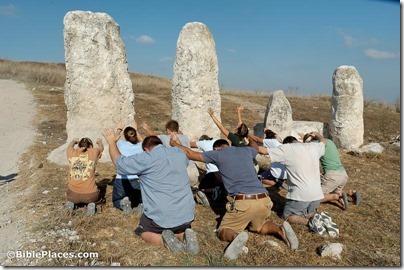This week’s sandstorm in Israel is the worst it has experienced since the nation was founded in 1948.
Air pollution in Jerusalem was 173 times higher than average. Carl Rasmussen shares a video showing how bad it was on the Mount of Olives.
What exactly is a 100-foot-deep shaft doing next to the Rockefeller Archaeological Museum in Jerusalem?
Andrew Bernhard posts on the End of the Gospel of Jesus’ Wife Forgery Debate.
Thieves in Galilee were caught removing a sixth century mosaic church floor in Gush Tefen.
The cisterns at Arad are now open to visitors.
Muslim “sentinels” protecting the Temple Mount from “sacrilege” have now been outlawed by Israeli police.
If your interest is in exotic shofars and what Jewish halakah has to say about it, Zoo Torah has a free pdf on the subject.
The BBC reports on six “lesser-known wonders of the ancient world,” including the site of Baalbek in Lebanon.
The Jerusalem Post Magazine reports on sinkholes around the Dead Sea. (At the moment of posting this, the link is not working. Perhaps it will return.)
ISIS is destroying ancient buildings in order to conceal evidence that they are looting for profit.
The Institute for Digital Archaeology plans to distribute 10,000 3-D cameras in the coming year in
order to document archaeological sites and objects in West Asia before they are destroyed.
A luncheon will honor James F. Strange at this ASOR meeting in Atlanta.
Ferrell Jenkins illustrates what David meant when he wrote about “a dry and weary land where there is no water.”
Did you know that the Upper Room is located directly above David’s Tomb?
The Dead Sea Scrolls scam at the California Science Center closed this week.
“The Manar al-Athar open-access photo-archive (based at the University of Oxford) aims to provide high resolution, searchable images, freely-downloadable for teaching, research, heritage projects, and publication. It covers buildings and art in the areas of the former Roman empire which later came under Islamic rule (e.g. Syro-Palestine/the Levant, Arabia, Egypt, and North Africa), from ca. 300 BC to the present, but especially Roman, late antique, and early Islamic art, architecture, and sacred sites.”
HT: Charles Savelle, Ted Weis, Agade, Joseph Lauer, Jared Clark
Our Facebook photo with the most clicks in the past week was the final one in our “holy rocks” series.
